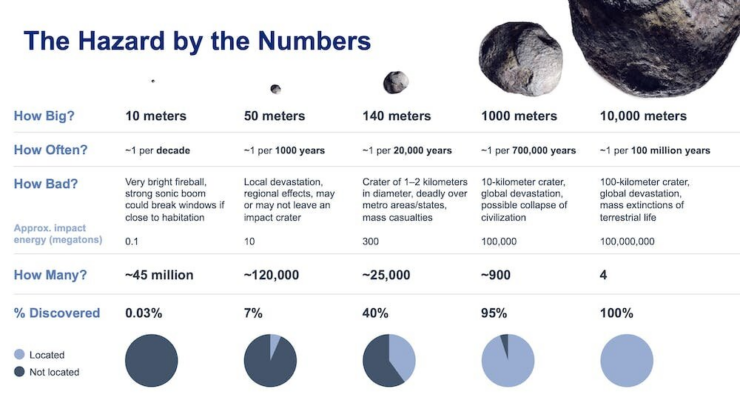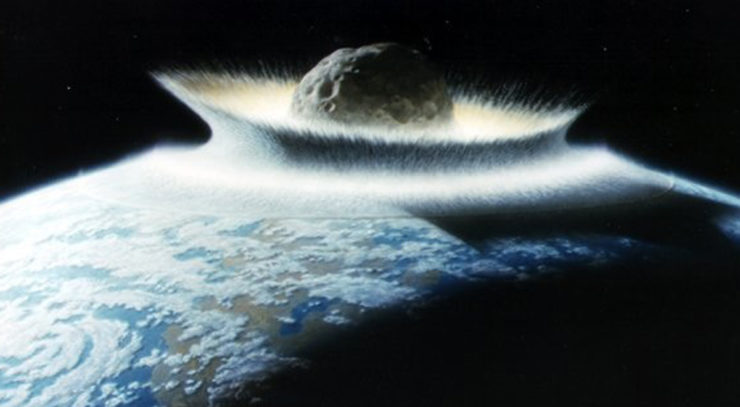NASA recently published an infographic (see below) which continues their relentless efforts to undermine hard-working science fiction authors.
With no regard at all for writers speculating about astronomical calamities, scientists have documented all known larger space rocks, considerably reducing the odds that the Earth could find itself presented with an imminent extinction-level impact. There may be rocks out there that we haven’t documented…but we’re now capable of spotting impactors well before impact. And it’s been proven that surprisingly modest methods may be sufficient to divert those scary space rocks.

Will no one think of all the poor SF authors who are now deprived of a successful stock plot?
But authors are ingenious! Here are five works in which calamitous asteroid and comet impacts occur despite the best efforts of scientists to spoil the game.
An obvious solution is to set one’s story sufficiently far in the past that modern observations cannot play a role. Mary Robinette Kowal selected March 3rd, 1952 as the date on which the characters of her 2018 The Calculating Stars survived a Chicxulub-scale asteroid impact. Because the rock impacts Earth decades before the start of comprehensive work to document such asteroids, the impact comes as a terrible—and, for millions of people, final—shock.
I have a friend who decades ago was obsessed with the odd causality of Choose Your Own Adventure stories. A specific example that comes to mind is one in which whether or not a volcano erupted appeared to be determined by whether one turned left or right at a crossroads. The Calculating Stars’ history diverges from ours well before the meteor strike, when Dewey wins his Presidential victory. The cause and effect sequence is somewhat unclear to me, but it’s clearly very good for us all that Truman won in the history that we know.
Another reasonable alternative is to present humanity with an impactor so huge that knowing about it beforehand is virtually useless. Human civilization in Arthur C. Clarke and Stephen Baxter’s 2000 The Light of Other Days is well aware that vast rock dubbed Wormwood is slated to smash into the Earth five centuries hence. However, lacking any reasonable means by which to divert a supermassive body like Wormwood, they leave the issue to the future to solve and focus on more immediate challenges like ending privacy forever.
Wormwood having been spotted so early, it touches on an issue relevant to sublight interstellar probes: given the likelihood of technological progress, does it make more sense to defer certain projects on the assumption that better machines will accomplish the task faster, even taking into account the delay to develop them, or would one be squandering previous time? Wormwood is a fine example of one of those two alternatives.
Another plot twist: smaller rocks, regional impacts. Regional catastrophes matter a heck of a lot to the people living in those regions. Given the right international circumstances, a merely local catastrophe could have global consequences. The antimatter rock that impacts the US in H. Beam Piper’s 1959 “The Answer” only annihilates Auburn, New York. However, because the event superficially resembles a nuclear attack, it triggers World War Three.
Human conflict being the constant that it is, authors might reasonably turn to deliberate human orchestration to deliver to Earth the impactor doom nature seems unlikely to provide. In Elizabeth Bear’s 2004 Scardown, China delivers a high-energy impact for which the victims’ space defenses prove woefully inadequate. This regional calamity depopulates large areas around the Great Lakes, whether US or Canadian. Of particular concern to me, as a Canadian living in Canada’s urban corridor: more Canadians were taken out than one might expect given Canada’s overall population density. On the plus side, Alberta and British Columbia were doubtless happy to get a larger share of Parliament seats.
Finally, just because we know doom is barreling towards us and just because we have the technological means to prevent it does not mean we will muster the political will to do so. The 2021 movie Don’t Look Up comes to mind. Astronomers Kate Dibiasky and Randall Mindy provide humanity with six months warning of a calamitous impact…six months that political and business leaders proceed to squander for selfish reasons.
I’d assert that the film’s premise is deeply implausible—who would be dumb enough not to use the tools at hand to save their own lives?—except that audiences found doom-by-shortsightedness entirely plausible. Online commenters came up with so many inspirational real-world examples that people heatedly disagreed as to which one in particular inspired the film. Cue the inevitable laugh-crying GIF (or possibly that sculpture of politicians debating climate change).
***
Of course, these are just the first five plot hacks that came to mind. No doubt there are others. If you can think of any particularly enticing possibility, please mention them in the comments, which are, as ever, below.
In the words of fanfiction author Musty181, four-time Hugo finalist, prolific book reviewer, and perennial Darwin Award nominee James Davis Nicoll “looks like a default mii with glasses.” His work has appeared in Interzone, Publishers Weekly and Romantic Times as well as on his own websites, James Nicoll Reviews (where he is assisted by editor Karen Lofstrom and web person Adrienne L. Travis) and the 2021 and 2022 Aurora Award finalist Young People Read Old SFF (where he is assisted by web person Adrienne L. Travis). His Patreon can be found here.










